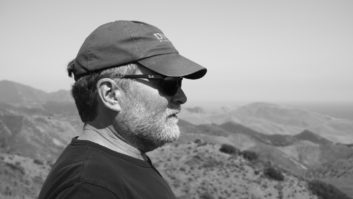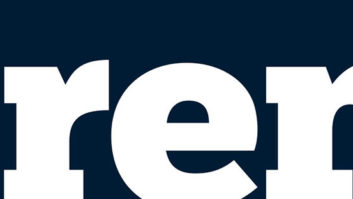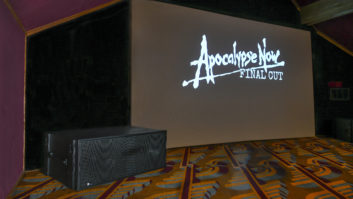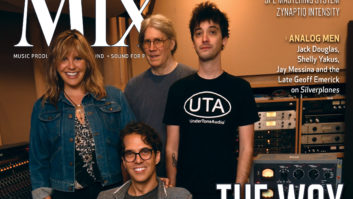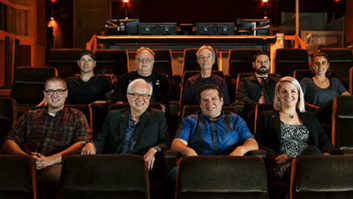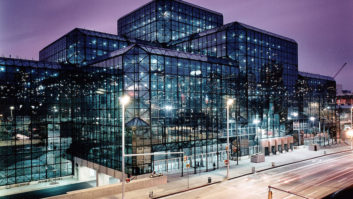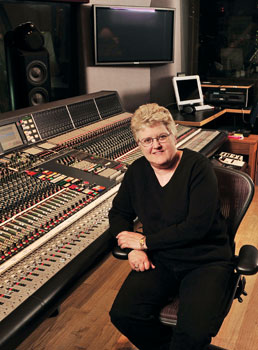
Skywalker’s director of scoring and music recording, Leslie Ann Jones
Photo: Steve Jennings
On a warm, late-June day, Skywalker Ranch, in the rustic wilds of West Marin County, Calif., is buzzing with activity. Seventh Moon, the latest film from director Eduardo Sanchez (of Blair Witch Project fame), has just wrapped post-production in the Technology Building and there is celebration in the air. Meanwhile at Skywalker Sound, the ranch’s impressive recording studio in that same building, the Cypress String Quartet is busy cutting a new CD of early Beethoven music. On the beautiful, cavernous Scoring Stage, the San Francisco-based foursome is comfortably ensconced in the same custom, German-made diffusers shown in our cover photo, which depicts an earlier session there with the Kronos Quartet, also regulars at Skywalker for many years.
With recent album work by Steve Miller, Warped Tour faves All-American Rejects and legendary Bay Area punk group Rancid in the studio’s rearview mirror, and scoring sessions for the next installment of the mega-popular videogame Gears of War on the near horizon, Skywalker Sound appears to be thriving during a period that has seen steep downturns for many recording studios. Over lunch on the back porch of the ranch’s white-clapboard Victorian mansion-style Main House, the studio’s director of scoring and music recording (not to mention record producer and Grammy-winning engineer), Leslie Ann Jones, notes that it is exactly that sort of diversification that has kept her studio busy: film and game scores, major- and indie-label work, classical and rock music, local and national talent.
“With the way budgets have changed and with more people recording at home, there are some projects we’ve gotten in the past that we’re not getting now,” she acknowledges, “but we’ve been very fortunate to have other projects taking their place, whether it’s bands that haven’t worked here before or the videogame [scoring] work, which we’re getting more and more of. What I’ve spent a lot of the past 11 years doing is getting people to understand that Skywalker is a place that anyone can come to and afford. I still get people saying, ‘Oh, I thought only George Lucas [founder of Skywalker] did his projects there.’ Those questions never end, so part of my job is to be the ambassador to the studio. It helps that we get Grammy nominations and awards and there’s a lot of visibility, but it’s always going to be a challenge to get people to come up here, and I have to look for new ways — with my studio director hat on — to fill this space.”
Certainly, the studio’s reputation precedes it. Since it opened in 1987, Skywalker Sound has been one of the true jewels of the Bay Area recording community — a breathtakingly beautiful and serene getaway less than an hour from San Francisco, with a stunning main room perfect for everything from huge orchestras to chamber ensembles to rock bands, four iso rooms and a large, comfortable control room equipped with state-of-the-art gear: Neve 88R console; Pro Tools HD, two Studer 827 analog machines, and other analog and digital recording systems; a custom Allen Sides/Ocean Way main monitoring system; near-fields by B&W, Tannoy, M&K, Meyer Sound, ATC, Genelec and Yamaha; M&K surrounds; and a great selection of new and vintage mics and outboard gear.
Jones — whose storied career includes production stints at ABC and Capitol Studios in her native Los Angeles, The Automatt in San Francisco and Skywalker for the past 11 years — keeps up to date technologically by being a working engineer and producer herself, staying heavily involved with NARAS (she’s a past chair of its Board of Trustees) and listening to the needs of her studio’s diverse client list. “On the Scoring Stage, we were relatively late adopters of Pro Tools,” she admits. “We opted for the [Euphonix] R1 instead because it was 48 channels at 96k, and at that time Pro Tools was not. So we were able to do some stellar projects on the R1. If you’re in this business long enough, you tend to work on the newest and the best, but somehow some of them never quite make it to the second generation, whether it’s the 3M digital multitrack or the Mitsubishi X-800 Series or the R1. All were great and sounded fantastic; all not available now. When Pro Tools came out with HD and we could get 48 channels at 96k and, the most important thing, we could back up very easily, we finally went in that direction.”
Keeping up has also meant having the latest generation of plug-ins available: “Absolutely! There are a lot of younger engineers who come in who are more comfortable using plug-ins [rather than analog outboard gear], so we have to have those available. Also, we get a lot of engineers who come in with our scoring clients where they’re mixing things at the composer’s house, and maybe [Audio Ease] Altiverb is all they’ve got there and they love it, so it doesn’t matter that we have a [Lexicon] 960 and three 480s and the original 224. [Laughs] So that end of it is always changing, but getting people in the door still involves networking, repeat customers, word-of-mouth, publicity and good service.”
Of course, having a genuine Shangri-La as your calling card doesn’t hurt, either.
Blair Jackson is Mix’s senior editor.
